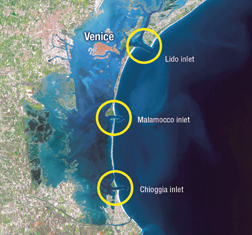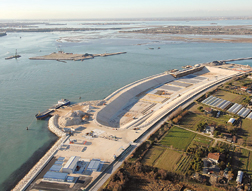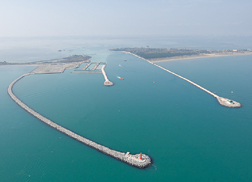Venetians have waited for centuries for a solution to tidal flooding of their famous lagoon. Although visible elements of a $6.7-abillion barrier system are largely now in place, funding shortfalls may further test the patience of the island’s citizens as engineering officials warn of delay.
| + click to enlarge |
 Venice Water Authority/Consorzio Venezia Nuova
|
 Venice Water Authority/Consorzio Venezia Nuova
|
 Venice Water Authority/Consorzio Venezia Nuova Work at Venice lagoon’s inlets includes marina to double as casting yard at Lido (middle) and Malamocco breakwater (above).
|
The vast consortium with the turnkey responsibility for safeguarding Venice is now preparing to build caissons across the lagoon’s three inlets. Caissons will house oscillating buoyant flap-gates that will pivot from the seabed around five times a year to isolate the 550-sq-kilometer lagoon from high Adriatic Sea tides that submerge the historic city.
Starting construction in 2004, the consortium Consorzio Venezia Nuova (CVN) has so far completed over 40% of the project. Harbors have been built at the Chioggia and Lido inlets to shelter small craft approaching new locks when gates are up. At Malamocco, Europe’s biggest ship lock is being completed along with a new 1.4-km-long breakwater. A smaller breakwater has been built at Chioggia.
With its schedule adjusted annually to government funding limits, CVN is heading for a delay, warns Maria Giovanna Piva, president of Venice Water Authority, the government agency in charge. Between November 2002 and this January, the government allocated $3.5 billion to the project, about half the total budget. But Piva recently alerted ministers in Rome that, at current spending rates, the project will likely overshoot its 2012 completion target by two years.
Venetians are accustomed to battling with their marine environment, having struggled with siltation and flooding for centuries. They diverted rivers away from the lagoon to prevent silting, doing it too effectively. Now, with sediment being flushed out, the lagoon’s varied ecology is threatened, says CVN’s engineering manager, Maria Teresa Brotto.
Flooding also tested generations of Venetian engineers, most worryingly in the last century. Brotto cites research attributing worsening flooding to a 23-centimeter drop in the lagoon’s ground level. About one-third was caused by industrial development.
Long History
After a major flood in 1966, the government decided to act. In 1975, it called for international ideas to deal with floods, but none passed muster. Then, in 1982, a team of experts produced a scheme to permanently narrow the inlets and install gates. That too was environmentally unacceptable. In 1984, the government decided to create a concessionaire to come up with solutions to lagoon flooding and ecological degradation.
|
Because of the lagoon’s many interacting systems, the government adopted a systemic approach, says Piva. It passed a law granting CVN full responsibility, from basic studies to finally operating the barrier for three years from its completion. The consortium is monitored by numerous bodies and reports to VWA.
VWA’s founding all the way back in 1501 reflects Venice’s historic and unique relationship with water. Now part of the infrastructure ministry, it is charged with safeguarding the lagoon, the city of Venice and infrastructure of the wider region.
Some 50 Italian contractors of all types and sizes own CVN. Rather than operating as an integrated joint venture, companies take on individual tasks. For example, consortium member Grandi Lavori Finconsit S.p.A. is handling around $150 million of caisson work at Malamocco.
“The consortium has the possibility in its group of finding all kinds of [specialization] that up to now they have required,” says Saverio Baccini, a senior manager with VWA’s supervising design firm Lotti-Thetis-Servizi di Ingegneria S.C. a R.L. “This is one of the advantages of this kind of organization.”
 |
| PIVA |
But the organization also creates potential for interface clashes between adjacent sites, adds Baccini. Conflicts of interest also can arise between consortium members, to be resolved by CVN.
CVN’s dispersed ownership is not evident to designers, however. “I don’t feel it is a big group,” says Alberto Scotti, president of the project’s design firm, Milan-based Technital S.p.A. “You feel you are talking to a real public administration.”
As well as the barrier, CVN is well advanced with parallel projects, together costing around $5 billion, estimates Piva. Work includes restoring sedimentation and salt marshes, improving water quality, reinforcing the inhabited 60-km littoral strip across the lagoon mouth and fixing old breakwaters.
In 1992, CVN presented its general plan to the government and secured approval. Mainly because of widespread interest in the lagoon’s ecology, the scheme’s design has been a “crazy activity,” says Scotti. Opposition was intense during its ...


Post a comment to this article
Report Abusive Comment